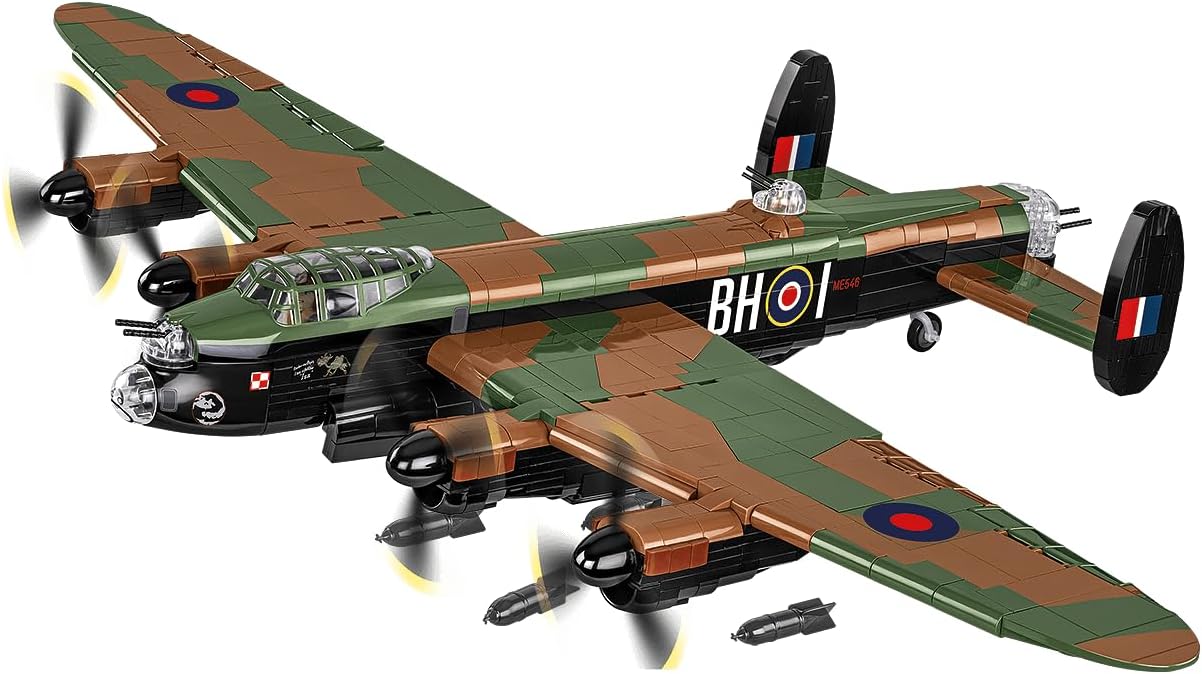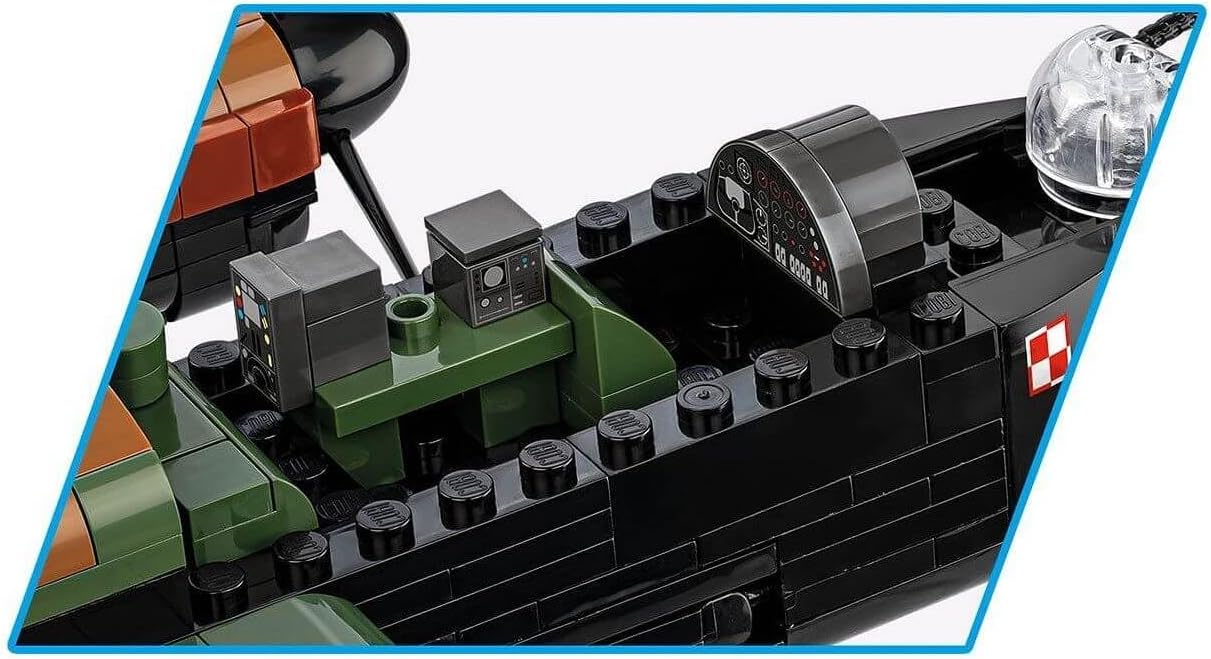Cobi 1/48: Avro Lancaster B. III
The Avro Lancaster is one of the most famous heavy bombers of World War II, renowned for its role in massive bombing campaigns over Germany.
Usually shipped within 24 hours
UK deliveries from £5.95
Delivery & Returns
Delivery & Returns
We use the Royal Mail, DHL Express or UPS for our customers. For UK addresses, deliveries under 10kg are a standard £4.95 via Royal Mail Tracked 48 Service. For orders over 10kg and overseas customers, postage is calculated for you at checkout once you have entered your postal address. This price, does not include any potential custom charges that may apply, depending on the product or destination, as every country has very different import duties / taxes. Online exclusive products (such as trainers) will be delivered to you directly from the printer, separate from other items in your order, but your postage fee covers ALL items in your order.
If you are unhappy with your purchase, please email shop@tankmuseum.org within fourteen (14) working days of receiving your goods, and return it to us at the address below, in its original condition, unopened (with any seals and shrink-wrap intact) and we will issue you a full refund or replace it. Goods must be returned at your own cost. If the item is faulty, you do not need to return it, we will send you a replacement free of charge.
Description
Description
Cobi 1/48: Avro Lancaster B. III
The Avro Lancaster is one of the most famous heavy bombers of World War II, renowned for its role in massive bombing campaigns over Germany. Developed and manufactured by Avro, a British aircraft manufacturer, the Lancaster first saw service with the Royal Air Force (RAF) in 1942 and quickly became a cornerstone of Britain's strategic bombing offensive.
The Lancaster was born from the unsuccessful Avro Manchester, which suffered from unreliable engines and other design flaws. Avro's chief designer, Roy Chadwick, redesigned the Manchester, replacing its problematic Rolls-Royce Vulture engines with four more reliable Merlin engines. This fundamental change, along with modifications to the wing and fuselage, gave rise to the Lancaster.
The bomber featured a distinctive twin-tail design and a capacious bomb bay, allowing it to carry a greater variety and larger size of bombs than any other British bomber of the era. It could carry loads up to 22,000 pounds, including the massive "Grand Slam" bombs.
The Lancaster officially entered service in 1942, with its first operational mission targeting Cologne, Germany. It quickly proved superior to its contemporaries in terms of speed, altitude capabilities, and bomb load. Its operational flexibility was demonstrated in various pivotal missions throughout the war.
One of the most famous missions involving the Lancaster was Operation Chastise, carried out by the RAF's No. 617 Squadron, known as the "Dambusters." In this daring raid in May 1943, Lancasters used specially designed "bouncing bombs" to breach the Möhne and Edersee Dams in Germany's Ruhr Valley. This raid showcased the Lancaster’s ability to deliver precision attacks on strategic targets.
The Lancaster was central to the RAF's night-bombing campaigns. It participated in the infamous 1,000-bomber raids, a series of massive attacks on German cities intended to overwhelm enemy air defenses and demoralize the German populace. The most devastating of these raids was on Dresden in February 1945, which resulted in tremendous destruction and loss of life.
By the end of World War II, Lancasters had flown over 156,000 missions and dropped over 600,000 tons of bombs. With a total production of almost 7,400 units, the Lancaster was a symbol of British industrial capability and aerial power.
After the war, it continued to serve in various roles, including maritime patrol and search and rescue, until it was finally retired in the late 1950s.
![Cobi 1/48: Avro Lancaster B. III Brick Model Kit [variant_option4]](http://tankmuseumshop.org/cdn/shop/files/61q4TF0BLnL._AC_SL1500.jpg?v=1727880650&width=1214)

![Cobi 1/48: Avro Lancaster B. III Brick Model Kit [variant_option4]](http://tankmuseumshop.org/cdn/shop/files/61iaYHf_14L._AC_SL1500.jpg?v=1727880650&width=1214)

![Cobi 1/48: Avro Lancaster B. III Brick Model Kit [variant_option4]](http://tankmuseumshop.org/cdn/shop/files/71tsvlNjvxL._AC_SL1500.jpg?v=1727880683&width=1214)

![Cobi 1/48: Avro Lancaster B. III Brick Model Kit [variant_option4]](http://tankmuseumshop.org/cdn/shop/files/51sLnNJYoOL._AC_SL1500.jpg?v=1727880650&width=1214)

![Cobi 1/48: Avro Lancaster B. III Brick Model Kit [variant_option4]](http://tankmuseumshop.org/cdn/shop/files/61l9wrlTc7L._AC_SL1500.jpg?v=1727880650&width=1214)

![Cobi 1/48: Avro Lancaster B. III Brick Model Kit [variant_option4]](http://tankmuseumshop.org/cdn/shop/files/61OIGZvzmiL._AC_SL1500.jpg?v=1727880650&width=1214)

![Cobi 1/48: Avro Lancaster B. III Brick Model Kit [variant_option4]](http://tankmuseumshop.org/cdn/shop/files/61tn3WXyLZL._AC_SL1500.jpg?v=1727880650&width=1214)

![Cobi 1/48: Avro Lancaster B. III Brick Model Kit [variant_option4]](http://tankmuseumshop.org/cdn/shop/files/61q4TF0BLnL._AC_SL1500.jpg?v=1727880650&width=112)
![Tank Museum Playing Cards Game [variant_option4]](http://tankmuseumshop.org/cdn/shop/files/ProductShoot_10_10_2025035.jpg?v=1760358498&width=176)
![Tank Museum Wrapping Paper - Two sheet pack Wrapping Paper [variant_option4]](http://tankmuseumshop.org/cdn/shop/products/Wrapp_Paper_All.jpg?v=1748337915&width=176)
![Cobi 1/48: Avro Lancaster B. III Brick Model Kit [variant_option4]](http://tankmuseumshop.org/cdn/shop/files/61q4TF0BLnL._AC_SL1500.jpg?v=1727880650&width=640)



